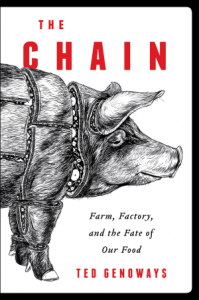I no longer eat beef. It was a decision inspired by listening to Meat Week on NPR’s Morning Edition in the summer of 2012. I imagine that the series was intended to whet the nation’s appetite for summer grilling season, yet somehow I emerged from the experience with the precise opposite result. As the entire process of producing beef was illuminated, I concluded that I no longer wished to be a consumer of that product.
 So, you’ll understand that I expected a similar result when I sat down recently to read The Chain: Farm, Factory, and the Fate of Our Food by Ted Genoways, a riveting examination of the workings of the pork industry.
So, you’ll understand that I expected a similar result when I sat down recently to read The Chain: Farm, Factory, and the Fate of Our Food by Ted Genoways, a riveting examination of the workings of the pork industry.
Let me offer you a taste:
From a pure business standpoint, the project of industrializing hog production has been an unparalleled success – and a logistical wonder. Every working day, about 175 trailers in various parts of Iowa, eastern Nebraska, and southern Minnesota are loaded with 170 hogs each; they converge onto one of a dozen loading docks in Fremont and Austin, arriving within a one-hour window of each other, in order to deliver roughly 30,000 hogs for slaughter. That’s every day for 260 working days, every year – 7.7 million hogs, herded through a tiny set of chutes, slaughtered, butchered, and sent out for additional value-added processing, at just those two plants. For the system to work, a four-month growing cycle must culminate with an exact-weight animal at just the right time. That precision must be carried out at hundreds of feeder sites, and the whole cycle, from insemination to slaughter, must be exactly replicated three times a year.”
As expected, the book has a great deal to say about the treatment of the animals. I was less prepared for the author’s devastating assessment of the treatment of the people who work in the industry’s plants. For example:
…[this person] told me she understood why the union didn’t want to discourage anything that created jobs but cautioned that line speeds in meatpacking plants are now “dangerously fast.” … FSIS [the USDA’s Food Safety and Inspection Service] doesn’t have time to watch out for – much less document – risks to worker safety … the focus is on the safety of the food … injuries and amputations are inevitable … in such an incident, FSIS will deal with it as a sanitary issue and will stop operations to make sure that all human blood is completely cleaned off and that all product is protected … FSIS will not release the area or the line unless all products are identified as protected and cleaned – or whatever needs to be condemned is condemned because it cannot be made clean.”
So what does this have to do with growing audiences for arts & culture?
Well, let’s marvel at the efficacy of production that the author describes. There is demand – and it didn’t just “happen” – it was carefully and creatively cultivated over time. Further, every detail of production has been studied, every variable controlled for, and every effort at productiveness has been made. From a functional perspective, the inputs and outputs connect with the complexity of a majestic symphony and the grace of finely choreographed ballet.
Yet, we can never escape the reality that the product can not be separated from the process by which it is created. Every delicious bite of bacon constitutes the consumer’s vote in favor of the entirety of the system that delivered it – including the treatment of the animals and the safety and dignity of the company’s workers.
In sum, the pork industry has crafted a robust business model providing items that consumers want. It’s business processes are imperfect, but one hope/expects that animal treatment, ecological impact, worker dignity and other issues are addressed and improved over time. Right?
So, when we look at the arts & cultural sector as a whole, can we honestly claim that our organizations are built on a robust business model that provides services that consumers or our communities want? And more, lacking such a solid foundation, how can we ever expect to address the significant imperfections of survivability and sustainability that plague our own industry (as summed up succinctly by the National Center for Arts Research at Southern Methodist University):
Nearly every nonprofit sector of the arts in America faces serious challenges. The National Endowment for the Arts’ 2008 Survey of Public Participation in the Arts revealed double-digit declines in the percentage of Americans who attended the arts from 2002 to 2008, as well as increases in average audience age over the same period. Personal spending in arts and culture has fallen significantly over the past decade, resulting in a net loss of $45 billion for the sector. Donations to the sector have also declined over the past 20 years by about $8 billion.”
So let’s ask this question: When you consider the pork industry and the arts & cultural sector, which more vividly reveals the immorality of a broken business model?
And what are we going to do about it?
# # #
